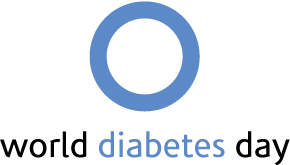- Privacy Policy
- Terms & Conditions
- Contact us
- ©Isabel Healthcare 2025
World Diabetes Day (WDD) 2015 - go blue for breakfast
 Saturday 14th November marks the 24th World Diabetes Day. The World Health Organisation, in collaboration with the International Diabetes Federation, organise and support fundraising, educational lectures, and even some meetings to try and further research and raise awareness of Diabetes, all on the birthday of the co-founder of insulin, Frederick Banting.
Saturday 14th November marks the 24th World Diabetes Day. The World Health Organisation, in collaboration with the International Diabetes Federation, organise and support fundraising, educational lectures, and even some meetings to try and further research and raise awareness of Diabetes, all on the birthday of the co-founder of insulin, Frederick Banting.
What is diabetes?
It’s a disease most people know about, and as 29 million people in the US and 3.9 million in the UK have been diagnosed with the disease, chances are you know someone with either type 1 or type 2 diabetes. But what does it actually mean, and what is the difference between Type 1 and 2? Diabetes is all about insulin and high blood sugar levels. The role of insulin in the body is to absorb glucose in the blood and liver and convert it into energy. Diabetes, in different ways depending on the type, is caused when that insulin is unable to be made by the body, or it cannot absorb the glucose in the blood.
Type 1 diabetes: Type 1 Diabetes is not linked to weight gain and is the least common form of diabetes. Although not entirely heriditary, there is evidence that the condition has some genetic links; your chance of getting type 1 diabetes increases if a blood relative has the same condition. Type 1 diabetes, sometimes known as insulin dependent diabetes, is caused by the pancreas struggling to produce enough insulin to absorb the glucose in the body.
Type 2 diabetes: This is the much more common type, and is closely linked to being overweight, or having an unhealthy diet. Blood sugar levels become too high when the body starts to resist the insulin trying to absorb the glucose in our blood from the food we eat. Type 2 diabetes can sometimes be controlled by a change in diet, in an effort to reduce the total sugars consumed in foods full of carbohydrates or sugar, and also reduce weight so the body and insulin are more able to deal with the glucose in the body.
The main symptoms to watch out for in diabetes are:
- Frequent urination
- Increased thirst
- Fatigue
- Increased hunger
If you get any of these or other symptoms, run them through the Isabel Symptom Checker to see what else comes up, and then discuss the results with your doctor.
What I can do this WDD 2015?
Rather than having a brand new focus every year, the WDD campaign changes its direction every few years, with particular sub-categories to talk about each year. The main campaign from 2009 - 2013 was ‘education and prevention.’ Since 2014 however, the focus has been ‘Healthy Living and Diabetes’ and this year there is a particular attention to Breakfast and the importance of starting the day off well. The international logo for diabetes is a blue circle, so this November, the campaign is encouraging everyone to ‘go blue for breakfast’ by meeting in groups to have a healthy breakfast whilst wearing blue. There will be an online platform showcasing all the breakfasts from around the world, with interviews with health experts and chefs to educate on the most important meal of the day. In addition to this initiative, people are encouraged to dress in blue for the day, and wear the blue circle logo pin.

Jason Maude
Jason is the CEO and Co-founder of Isabel. Prior to co-founding Isabel, Jason spent 12 years working in finance and investment banking across Europe. His daughter, Isabel, fell seriously ill following a misdiagnosis in 1999 and this experience inspired Jason to abandon his city career and create Isabel Healthcare Ltd.
Subscribe Here!
Recent Posts
Isabel DDx Companion with ChatGPT Integration - to help you diagnose even faster
At Isabel Healthcare, we’ve always been driven by one goal: to make clinical reasoning faster,..Virtual Triage: Do more questions lead to better patient outcomes?
One of the common misconceptions related to virtual triage / symptom checker tools is that the more..List Of Categories
- Differential Diagnosis Decision Support
- Differential diagnosis
- Symptom Checker
- Symptoms
- Medical Error
- Patient Disease Information
- Disease
- Clinical Decision Support
- Diagnostic Decision Support
- Isabel 1 Minute Read
- Diagnosis Error
- Diagnosis Skills Cases
- Healthcare Informatics
- Clinical Reasoning
- Evidence-based Medicine
- Medical Education
- Patient Engagement
- Symptom Triage
- Nurse Practitioner Education
- Nursing Decision Support
- Partnership
- Public Health
- COVID-19
- EHR
- Patient Empowerment
- Patient Safety
- rare disease

Start your FREE Trial today
Try the Isabel Pro DDx generator for 30-days - no payment card details required.




